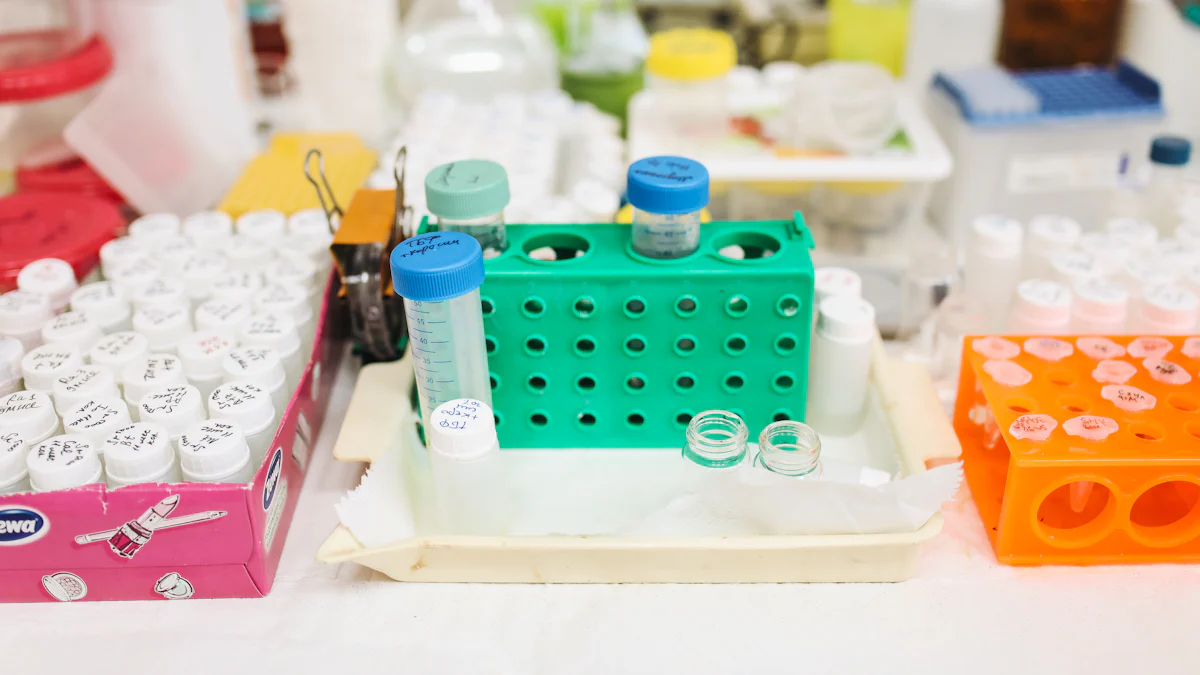Reliable pipette tips ensure precise liquid handling, safeguarding your experiments from errors. Poor-quality tips can cause leaks, inaccurate measurements, or contamination. For instance, improper attachment may lead to sample loss, while damaged tips compromise data integrity. Always choose high-quality pipette tips to maintain consistency. For expert guidance, contact us for tailored solutions.

Accuracy and Precision in Pipette Tips

Importance of Tip Design for Accurate Measurements
The design of pipette tips plays a critical role in ensuring accurate liquid measurements. Poorly designed tips can lead to leakage, inconsistent volume delivery, and contamination. To achieve precise results, you should look for tips with features such as:
- A secure fit to prevent air gaps and ensure consistent dispensing.
- Hydrophobic materials that minimize liquid retention and sample loss.
- Clear graduations for precise volume measurement.
- Compatibility with your pipette to avoid inaccuracies caused by improper attachment.
High-quality pipette tips are manufactured with precision to deliver uniform performance. Choosing tips from reputable manufacturers ensures adherence to strict quality standards, which is essential for reliable results.
Role of Fit and Seal in Preventing Leaks
A proper fit and seal between the pipette and the tip are essential for preventing leaks and maintaining accuracy. Poorly fitting tips can cause sample loss, introduce air bubbles, or result in dripping. These issues compromise the integrity of your experiments.
To avoid these problems, always select tips that fit securely on your pipette. Manufacturer-specific tips often provide the best fit, but universal tips designed for multiple brands can also work effectively. Regularly inspect the O-rings and seals on your pipette to ensure they remain in good condition. A secure seal guarantees consistent volume delivery and prevents contamination.
How Tip Volume Affects Precision
The volume capacity of pipette tips directly impacts their precision. Low-volume tips are ideal for applications requiring small, precise measurements, such as PCR. Medium-volume tips offer a balance between precision and capacity, making them suitable for general laboratory tasks. High-volume tips handle larger quantities without sacrificing accuracy, which is crucial for bulk liquid transfers.
For critical assays, low-retention tips are highly beneficial. These tips reduce liquid retention, ensuring that the entire sample is dispensed accurately. Selecting the correct tip volume for your application enhances precision and minimizes errors in liquid handling.
Sterility and Contamination Control

Why Sterile Pipette Tips Are Essential for Sensitive Applications
Sterile pipette tips are crucial for maintaining aseptic conditions in sensitive laboratory workflows. Using non-sterile tips can lead to several contamination risks:
- Pipette-to-sample contamination occurs when the pipette or tip introduces impurities into the sample.
- Sample-to-pipette contamination happens when liquid enters the pipette body, compromising its sterility.
- Sample-to-sample contamination arises when residual liquid from one sample transfers to the next.
To avoid these issues, you should always use sterile pipette tips, especially for applications like molecular biology or microbiology. Pre-sterilized tips from certified manufacturers ensure proper sterilization and eliminate contamination risks. Additionally, high-quality virgin polypropylene tips reduce the chance of leachables affecting your samples.
Benefits of Using Filtered Pipette Tips
Filtered pipette tips provide an extra layer of protection for your experiments. These tips prevent aerosols from entering the pipette, shielding both the pipette and the sample from contamination. This feature is especially valuable in sensitive applications like PCR or DNA sequencing, where even minor impurities can compromise results.
Filtered tips also maintain sample purity by blocking cross-contamination between samples. Their high bacterial filtration efficiency (up to 99%) ensures reliable outcomes. For novice researchers, these tips reduce the risk of accidental spillage or contamination, making them a practical choice for maintaining experimental integrity.
When to Choose Pre-Sterilized Pipette Tips
Pre-sterilized pipette tips are indispensable for experiments involving sensitive chemicals or biological samples. These tips protect both the pipette and the sample from contamination. They are certified free of DNA, RNase, and endotoxins, ensuring the highest level of sterility.
You should opt for pre-sterilized tips when working in molecular biology, microbiology, or any application requiring contamination-free conditions. These tips eliminate the need for autoclaving, saving time and ensuring consistent sterility. Their use minimizes biological contamination risks, making them a reliable choice for critical laboratory tasks.
Material Quality and Durability of Pipette Tips
Advantages of Virgin Polypropylene in Tip Manufacturing
The use of virgin polypropylene in pipette tip manufacturing ensures superior quality and purity. This material offers several advantages:
- It eliminates detectable contaminants like DNase, RNase, and pyrogens, which can compromise sensitive experiments.
- Strict cleaning protocols during production enhance the purity of the tips, making them suitable for critical applications.
- Virgin polypropylene complements sterilization processes, such as radiation, to minimize biological contamination risks.
By choosing pipette tips made from virgin polypropylene, you ensure reliable performance and maintain the integrity of your samples.
Low-Retention Tips for Handling Viscous Liquids
Low-retention pipette tips are essential when working with viscous substances like enzymes or reagents. These tips feature a hydrophobic inner surface that minimizes liquid adhesion. This design reduces sample loss and ensures accurate liquid transfer during experiments.
You benefit from improved accuracy and reliability when using low-retention tips. They are particularly effective for applications requiring precise handling of sticky or dense liquids. By reducing waste and enhancing precision, these tips streamline your workflow and improve experimental outcomes.
Sustainable and Recyclable Options for Eco-Friendly Labs
Sustainable pipette tips help reduce the environmental impact of laboratory operations. Consider the following:
| Environmental Impact | Description |
|---|---|
| Plastic Waste | Over 12 billion pounds of plastic waste generated annually from single-use plastics in labs. |
| CO2 Emissions | Production of a single 96-rack of polypropylene pipette tips releases approximately 0.304 kg of CO2 equivalent. |
| Water Usage | Requires about 6.6 liters of water to produce a single 96-rack of pipette tips. |
Reusing pipette tips is a viable solution. Validation studies from organizations like the NIH and CDC confirm that washed tips maintain the same quality as new ones. For example, a lab reusing each tip ten times could reduce CO2 emissions by 5.3 tons annually. By adopting recyclable or reusable options, you contribute to a greener laboratory environment without compromising performance.
Compatibility and Ergonomics of Pipette Tips
Ensuring Compatibility with Various Pipette Brands
Selecting pipette tips that are compatible with your pipette is essential for achieving accurate and reliable results. Incompatibility can lead to poor fit, leaks, or inaccurate volume delivery. To ensure compatibility, consider the following factors:
- Match the tips to your pipette's design to avoid inaccuracies.
- Use high-quality materials to prevent contamination.
- Choose tips that meet the volume requirements of your experiments.
- Select between standard or low-retention designs based on your application.
- Look for clear graduations for precise measurements.
- Opt for tips from manufacturers with quality certifications.
- Balance quality with cost to ensure cost-effectiveness.
By evaluating these factors, you can select pipette tips that enhance your workflow and maintain the integrity of your experiments.
Ergonomic Designs for User Comfort and Efficiency
Ergonomic pipette tips improve user comfort and efficiency, especially during repetitive tasks. Short pipette tips, for example, allow you to pipette closer to the bench when working with multi-well plates. This design reduces arm strain and enhances comfort during prolonged use. Lightweight and ergonomic pipettes further reduce hand fatigue, ensuring an optimal user experience. These features not only improve accuracy but also enhance overall laboratory efficiency. Prioritizing ergonomics in your pipette tips can significantly improve your productivity and reduce physical strain.
Comparing Universal and Manufacturer-Specific Pipette Tips
Choosing between universal and manufacturer-specific pipette tips depends on your specific needs. The table below highlights the advantages and considerations of each option:
| Type of Tip | Advantages | Considerations |
|---|---|---|
| Universal Pipette Tips | Versatile and convenient; can be used with various micropipettes. | May not provide optimal fit for all micropipettes, affecting accuracy. |
| Manufacturer-Specific Tips | Ensures secure fit and optimal performance, enhancing accuracy. | Typically more expensive and may require sourcing from specific suppliers. |
Universal tips offer flexibility, while manufacturer-specific tips provide a precise fit. Evaluate your priorities to make the best choice for your laboratory needs.
High-quality pipette tips are essential for achieving accurate and contamination-free results in laboratory work. You should prioritize features like material quality, sterility, and compatibility with your pipette. For sensitive applications, sterile and filtered tips prevent cross-contamination and protect sample integrity. Always match tip volume and design to your specific needs to ensure optimal performance.
Post time: Feb-12-2025

